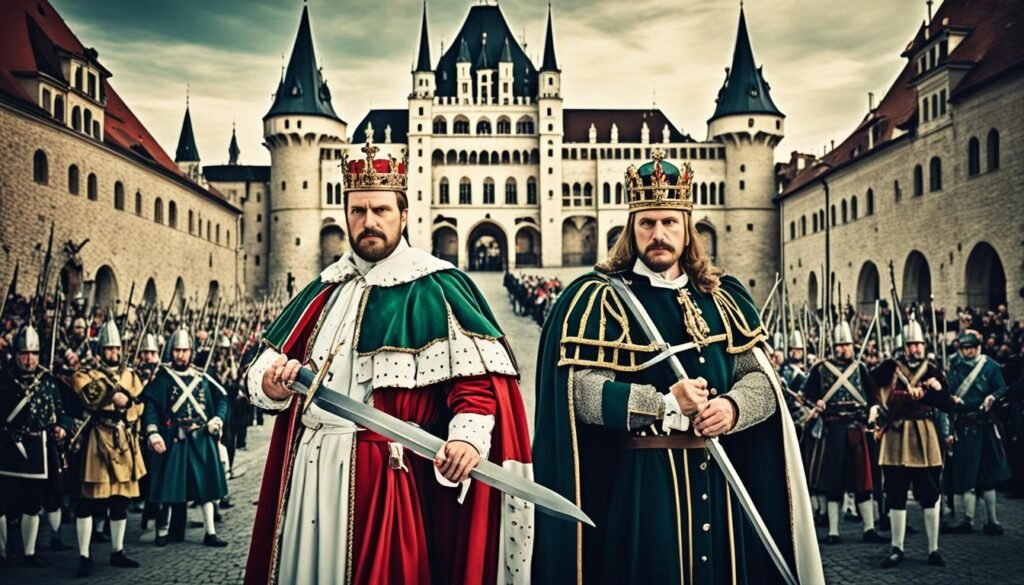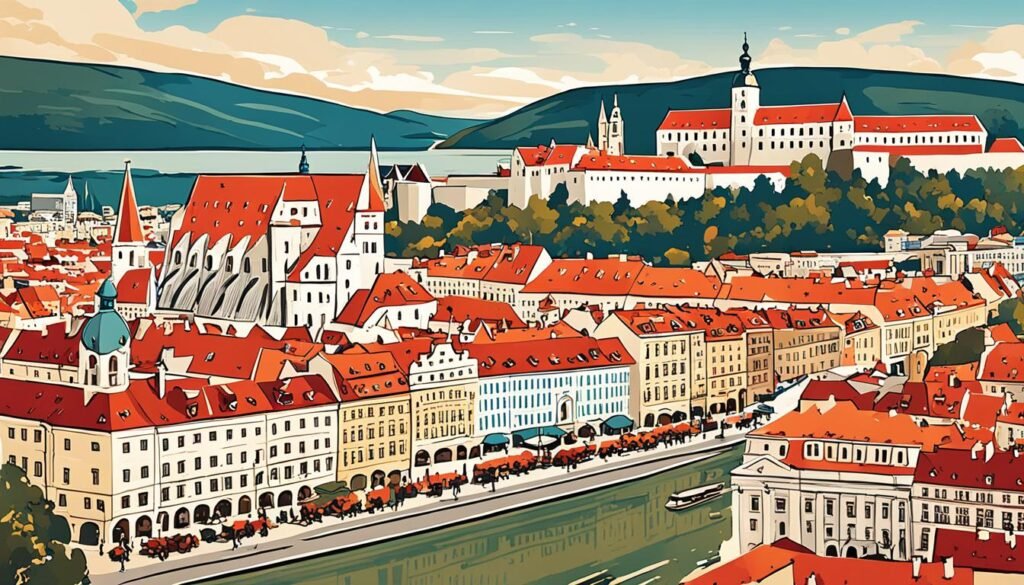Did you know that Bratislava, the capital of Slovakia, is the only national capital in the world that borders two sovereign states – Austria and Hungary? This unique geographical position has shaped the city’s rich and captivating history as a crossroads of Central European culture.
Situated at the heart of the Carpathian Basin, Bratislava has been influenced by a diverse array of peoples and civilizations over the centuries. From the Slavic settlers of the 5th century to the mighty Austro-Hungarian Empire, the city has been a hub of political, economic, and cultural activity in the region.
Crowned as the coronation site and legislative center of the Kingdom of Hungary for over 250 years, Bratislava’s historic old town is a testament to its storied past. The city’s iconic landmarks, such as the imposing Bratislava Castle and the Gothic-style St. Martin’s Cathedral, stand as enduring symbols of Slovakia’s Central European heritage.
Key Takeaways
- Bratislava is the only national capital that borders two sovereign states – Austria and Hungary.
- The city’s history has been shaped by diverse cultures, including Slavic, Austro-Hungarian, and more.
- Bratislava was the coronation site and legislative center of the Kingdom of Hungary for over 250 years.
- The city’s historic old town and landmarks, like Bratislava Castle and St. Martin’s Cathedral, showcase Slovakia’s Central European heritage.
- Bratislava is the political, cultural, and economic center of Slovakia, home to universities, museums, and other cultural institutions.
Introduction to Slovakia’s Rich History
Nestled in the heart of Central Europe, the landlocked nation of Slovakia boasts a captivating history that has been shaped by its unique geographical location and role as a crossroads of European civilizations. Bordered by Poland to the north, Ukraine to the east, Hungary to the south, Austria to the southwest, and the Czech Republic to the northwest, Slovakia’s diverse landscape is dominated by the majestic Carpathian Mountains and traversed by the iconic Danube River.
Geographical Location and Boundaries
Slovakia’s strategic position, sandwiched between the spheres of influence of the Austro-Hungarian Empire and the Ottoman Empire, has long been a defining feature of its history. The country’s borders have shifted numerous times, reflecting the ebb and flow of regional power dynamics, but its core geography has remained a constant. The Carpathian Mountains, which stretch across much of Slovakia’s northern and eastern regions, have played a vital role in shaping the country’s development, serving as both a natural barrier and a conduit for cultural exchange.
Historical Significance as a Crossroads of Europe
As a crossroads of Europe, Slovakia has been a site of frequent battles and invasions, but this has also contributed to its rich cultural diversity. The country’s location at the intersection of major trade routes and the movement of people and ideas has made it a hub of economic and intellectual activity, with a legacy that includes the vibrant city of Bratislava and the influence of the Austro-Hungarian Empire.

Ancient Origins and Early Settlements
Slovakia’s history stretches back thousands of years, with the earliest evidence of human habitation dating to the Paleolithic era. Archaeologists have uncovered artifacts near Nové Mesto nad Váhom that date back to an astonishing 270,000 BCE, providing a glimpse into the lives of our earliest ancestors.
As the millennia passed, the region saw the emergence of the Neanderthal people and the flourishing of the Gravettian culture, particularly along the river valleys of Nitra, Hron, Ipeľ, Váh, and in the vicinity of the Vihorlat, Inovec, and Tribeč mountains. These ancient settlements testify to the adaptability and resourcefulness of the region’s inhabitants, who thrived in the rugged yet bountiful landscape.
The Bronze Age brought significant advancements, with the region becoming a hub of copper production, especially in central and northwest Slovakia. This newfound prosperity fueled the growth of local communities and paved the way for the arrival of Thracian tribes during the Iron Age. The Hallstatt culture, named after a prominent archaeological site in Austria, took root in Slovakia, leaving behind monumental burial mounds and a legacy of expanded trade and agricultural practices.

From the Paleolithic to the Iron Age, Slovakia’s ancient past reveals a rich tapestry of human habitation and cultural development, setting the stage for the region’s remarkable journey through the centuries to come.
The Kingdom of Hungary and Habsburg Rule
In the 10th century, the territory of present-day Slovakia was incorporated into the Kingdom of Hungary, which later became part of the Habsburg Monarchy in the 16th century. Pressburg, now known as Bratislava, played a significant role during this period, serving as the new capital of Hungary in 1536 and the coronation site for eleven Hungarian kings and eight queens between 1536 and 1830.
Pressburg’s strategic location and political importance made it a frequent target of attacks and battles, shaping its diverse cultural landscape. The city was home to a variety of ethnic groups, including Austrians, Germans, Hungarians, and Slovaks, each contributing to the rich cultural influences that defined the region.
Cultural Influences and Historical Figures
Pressburg’s cultural vibrancy is evident in the legacy of notable historical figures associated with the city. One such figure is the renowned composer Wolfgang Amadeus Mozart, who performed in Pressburg in 1762. Another prominent name linked to the city is Joseph Haydn, the influential Austrian composer who also visited Pressburg during his lifetime.

The Kingdom of Hungary and the Habsburg Monarchy’s rule over Pressburg/Bratislava left an indelible mark on the city’s cultural identity, making it a reflection of the diverse influences that have shaped Central European history.
Slovakia: Central European History Bratislava Slovakia
Bratislava, the capital city of Slovakia, has a rich and captivating history that has shaped its architectural and cultural heritage. Formerly known as Pressburg or Pozsony, the city’s strategic location at the confluence of the Danube River and the Little Carpathians has contributed to its significance throughout the ages.
Bratislava’s Transformation into the Capital
In the 16th century, Bratislava became the capital of the Kingdom of Hungary, serving as the coronation site for many Hungarian monarchs. This period marked a significant transformation for the city, as it experienced a surge of prosperity and growth under the reign of Queen Maria Theresa during the 18th century. The construction of new palaces, monasteries, and other architectural landmarks during this time period cemented Bratislava’s status as a cultural and political hub in Central Europe.
Architectural and Cultural Heritage
Today, Bratislava’s well-preserved historic center, with its mixture of Baroque, Renaissance, and neoclassical styles, is a UNESCO World Heritage Site and a major tourist attraction. Visitors can explore the city’s rich cultural heritage by strolling through the charming Old Town, admiring the stunning Bratislava Castle, and discovering the numerous churches, cathedrals, and other historic landmarks that dot the cityscape. The city’s proximity to the Danube River and the scenic Little Carpathians further enhances its natural beauty and appeal.

The Velvet Revolution and Slovak Independence
After the dissolution of the Austro-Hungarian Empire following World War I, Slovakia became part of the newly formed state of Czechoslovakia. In the lead-up to World War II, local fascist parties gained power in the Slovak lands, leading to the establishment of the first Slovak Republic as a client state under Nazi German control.
Following the war, Czechoslovakia transitioned to communist rule, aligning itself with the Eastern Bloc. However, the Velvet Revolution of 1989 peacefully ended the communist regime, paving the way for Czechoslovakia’s transition to a market-based economy. In 1993, the Czech and Slovak Republics peacefully dissolved Czechoslovakia, with Slovakia becoming an independent state – a process often referred to as the “Velvet Divorce.”
The transition to independence and a market-based economy has been a significant part of Slovakia’s modern history. The country has since undergone significant political and economic reforms, solidifying its position as a thriving Central European nation.
Modern Slovakia and Its Global Role
Since becoming an independent state in 1993, Slovakia has transformed into a developed, high-income country with an advanced economy. As a member of the European Union, Eurozone, and Schengen Area, Slovakia has experienced steady economic and political development, cementing its place as a global player.
Economic and Political Developments
Slovakia’s economy is recognized for its strength, particularly in the automotive industry. In 2019, the country produced over 1.1 million vehicles, accounting for 43% of its total industrial output. This impressive manufacturing prowess has contributed to Slovakia’s robust economic growth, with the country’s GDP per capita now on par with other developed European nations.
Tourism and Cultural Attractions
Beyond its economic achievements, modern Slovakia is also a hub of cultural richness. The country boasts eight UNESCO World Heritage sites, including the historic center of Bratislava, the capital. Visitors are drawn to Slovakia’s natural beauty, such as the majestic High Tatras mountains, as well as its vibrant cities and towns, making it an increasingly popular tourist destination.
Preserving Slovak Heritage and Traditions
Despite Slovakia’s rapid modernization and integration into the global economy, the country has made concerted efforts to preserve its rich cultural heritage and traditions. The Slavic roots of the Slovak people are reflected in their vibrant folk customs, music, dance, and crafts, which continue to be celebrated and passed down through generations.
Folk Customs and Crafts
Traditional Slovak folk art, including woodcarving, embroidery, pottery, and lace-making, are highly valued and showcased in museums and cultural events throughout the country. Festivals and celebrations honoring Slovak heritage, such as the annual Východná Folklore Festival, help to maintain the connection between the country’s past and present, ensuring that the unique identity and traditions of the Slovak people endure.
The preservation of Slovak heritage and traditions is not only a matter of cultural identity but also a testament to the resilience and adaptability of the Slavic culture. As Slovakia continues to evolve and embrace modernity, its people remain steadfast in their commitment to safeguarding the timeless customs and artistry that have defined their nation for centuries.
Slovakia’s Influence on Central European Culture
As a crossroads of Central Europe, Slovakia has left an indelible mark on the cultural landscape of the region. The country’s capital, Bratislava, and its second-largest city, Košice, have both played pivotal roles in shaping the architectural and artistic heritage of Central Europe. The historic city centers of these two cities, with their harmonious blend of Baroque, Renaissance, and neoclassical styles, are a testament to Slovakia’s rich cultural legacy.
Beyond its architectural wonders, Slovakia has also made significant contributions to the broader Central European artistic tradition. Slovak composers, musicians, and artists have left an indelible imprint on the region’s cultural tapestry, further cementing the country’s place as an integral part of the cultural fabric of Central Europe. From the captivating melodies of Slovak folk music to the striking works of Slovak visual artists, the influence of Slovakian culture can be felt throughout the region.
The impact of Slovak culture on Central Europe is multifaceted and enduring. Whether it’s the awe-inspiring architecture of Bratislava and Košice or the artistic brilliance of Slovak creatives, the country’s influence is undeniable. As a cultural crossroads, Slovakia has played a vital role in shaping the unique identity of Central European culture, leaving an indelible mark on the region’s artistic landscape.
Conclusion
Slovakia’s fascinating history as a Central European nation is a testament to its strategic location, cultural diversity, and resilience in the face of various political and social challenges. From its ancient roots and early settlements to its time under the rule of Hungary and the Habsburgs, and its eventual journey to independence, Slovakia has forged a unique identity deeply rooted in Slavic traditions and a rich architectural and artistic heritage.
Today, the country continues to play a vital role in the cultural and economic landscape of Central Europe. As Slovakia looks to the future, its unwavering commitment to preserving its cultural heritage while embracing modernity will undoubtedly shape its continued evolution as a vibrant and influential nation at the heart of Europe. The nation’s strategic position, combined with its rich history and vibrant cultural traditions, makes Slovakia a fascinating destination for those seeking to explore the diversity and dynamism of the Central European region.
Moving forward, Slovakia’s ability to balance its proud past with a forward-looking vision will be crucial in ensuring its continued success and influence on the global stage. By preserving its unique identity while fostering strong international connections, Slovakia is poised to remain a key player in the cultural and economic fabric of Central Europe for generations to come.
Source Links
- Slovakia | History, Map, Flag, Population, Language, Capital, Currency, & Facts – https://www.britannica.com/place/Slovakia
- Slovakia – https://en.wikipedia.org/wiki/Slovakia
- Bratislava – https://en.wikipedia.org/wiki/Bratislava


